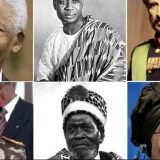Partition of India: History, Causes & Effects
The 1947 partition of the British India is one of the most pivotal points in not just India’s history but of south Asian history as well. The Indian partition led to a monumental migration like never seen before in the region; millions of Sikhs and Hindus took long, arduous journey to West Pakistan and Bangladesh. The partition, which in a way served as the precursor to Israel’s demands for a separate homeland from the Arabs, is also at the root of ongoing tensions between the modern states of Pakistan and India.
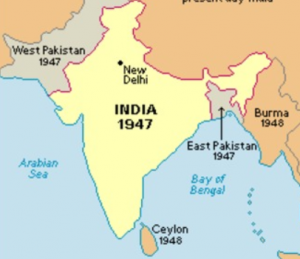
The partition divided British India into two countries – Hindu-majority India and Muslim-majority Pakistan. It caused one of the largest mass migrations in modern history. Millions found themselves in the “wrong” country, and those people had to move across the border.
Who partitioned India? And why did the partition occur in the first place?
Below, World History Edu takes a deep delve into Indian Partition, also known as the “Great Divide”. It also covers the causes and effects of the Partition of British India.
State of affairs in Pre-colonial India
A pre-colonial Indian subcontinent was a very colorful landscape as it could boast of many princely states that comprised people from different religious backgrounds, including Muslims, Hindus, Sikhs, Christians, Jains, and Buddhists, and among others. Even though the princely states had slightly different set of traditions, people on the subcontinent still managed to leave peacefully among themselves.
Furthermore, the arrival of Persianate Turks from places in what is now central Afghanistan on the Indian subcontinent brought cultural mixing between Hindus and Muslims. Barring the periodic conflicts that erupted between the two sides, efforts were always made to reduce the tensions. Some Indian Muslim princes in India even had some Hindu text translated into Persian.
Basically, the shared traditions that prevailed on the subcontinent meant that people did not define themselves solely on their religious faith. Instead, the shared culture in south Asia was based on common regional and local traditions, languages, and others.
The decades leading up to the Partition of India
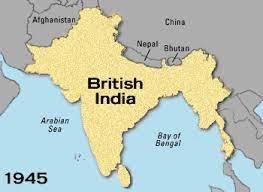
British India before the Partition
For almost 9 decades, from 1858 to 1947, the Indian subcontinent was under the British Colonial rule, either directly or indirectly. Regarding the latter type of rule, Britain allowed the princely states to have some bit of autonomy and be ruled by maharajas (Indian princes or Hindu monarchs).
However, by the end of the 19th century, a number of nationalist movements had begun forming. This was largely due to the fact that British policies in the area of transportation, communication and education had stirred up a lot of Indian nationalism in the region.
The Indians were disappointed by Britain’s continuous indifference to and alienation from the Indians and their culture. As a result, many Indian nationalists started making demands for self-rule.
After World War II, an even greater crusade for the independence of India started, with many of those activists becoming even more vehement. With time, they intensified their demand for self-government as a “reward” for their contribution during wartime. As for the All-India Muslim League, the leaders of the party wanted Great Britain to divide the country on religious grounds and then pack up and leave. This resulted in conflicts among the Sikhs, Hindus and Muslims.

Great Britain unilaterally took the decision to have India (then British India) involved in World War II. Westminster’s disregard for Indian interests before and during the war stirred up a lot of anti-Britain sentiments, which in turn increased the calls for full independence. Britain had to deal with the “Quit India” Movement started by the Indian National Congress.
On the other hand, the then-newly formed British government had hoped to grant independence in order to achieve some semblance of a united India before they left. However, the Indian National Congress and the All-India Muslim League were in disagreement with regards to the shape of the new state; nonetheless, repeated discussions were held to resolve this issue.
When the Muslim League leader Muhammad Ali Jinnah threatened a “direct action” (i.e. Direct Action Day in August 1946) aimed at forming a Muslim state, tensions erupted and spread to many parts of Bombay, Delhi and Punjab. Thousands of people lost their lives, properties were damaged and several people were injured. Fearing that a civil war could erupt, Britain was compelled to act fast.
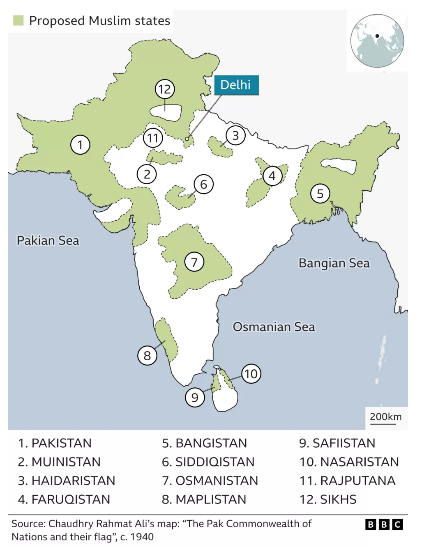
Proposed map for the partition of India. Image credit: BBC
Those tensions culminated in the 1947 partition that divided British India and birthed India and Pakistan as two independent nation. Lord Mountbatten, the last Viceroy of India, presided over this petition and later served as the first governor general of India until mid-1948. Mountbatten knew there was no way bloodshed could be avoided. He believed that a partition would cause less brutality and was the best way to avoid a civil war in the region.
India was divided in a way that cut through to two principal provinces, Bengal and the Punjab, depending on which area had Hindu, Sikh or Muslim majority. The two regions were about 1,000 miles from each other.
The Origin of Pakistan
“Pakistan” means the land of the pure. It was first coined in 1933 by Cambridge University law student Choudhry Rahmat Ali who conceived of a separate native land for Muslims in South Asia. As a result, many regard Rahmat Ali and philosopher Muhammad Iqbal as the two leading initiators of the Pakistan Movement.
Muhammad Ali Jinnah, who served as the leader of the all-India Muslim League from 1913, was the founder and first governor-general of Pakistan. Jinnah also worked to achieve a political unification of Hindu and Muslims and thus was dubbed “the best ambassador of Hindu-Muslim Unity.” However, with the Hindus making up about two-thirds of the entire population with the rest being mostly Muslims, he anticipated trouble stemming from religious differences.
By the 1940s, Jinnah had had a change of mind and was convinced that Indian Muslims should own their independent state in order to curb the issue of possible marginalization by the Hindus in an independent India.
Cyril Radcliffe, a British lawyer, was given the task of dividing over 170,000 square miles of 88 million inhabitants in five weeks. The demarcation, known as the “Radcliffe Line”, was carried out in secret in order to prevent related discords.
Finally, Pakistan and India became two independent nations through the Indian Independence Act 1947, which was passed on August 15, 1947.
Effects of the Indian Partition

Lord Mountbatten meeting with Nehru and Jinnah
Before the partition, many historians recount an attitude of brotherliness among the Hindus Sikhs and Muslims who lived together peacefully for many tens of decades. The partition, however, wrecked both India and Pakistan.
The celebrations that erupted following the departure of the British came to an abrupt end when people were confronted with the details of the partition. Some found themselves at the wrong side of the line, which in turn raised a lot of tensions. For example, the demarcation of Punjab and Bengal led to riots and the killing of some Hindus, Muslims and Sikhs. Many incidents of rape, thefts and loss of property were recorded. Women and children were abused and used as instruments of power by some Muslim and Hindu sects.
About 15 million refugees spilled over the borders in an attempt to be on the “correct” side of the border. This was really important to them because their identities were not based only on religion, but, more importantly, they were rooted in their ancestors’ geographical origin.
It is estimated that several tens of thousands of people lost their lives in the extreme violence that took place following the partition of India.
Another unpredictable outcome of the Partition was that Pakistan’s population became more religiously homogeneous than had been expected. The leaders of the Muslim League had thought that Pakistan would comprise a fairly large number of non-Muslims. However, by 1951, the non-Muslims in West Pakistan (present-day Pakistan) accounted for about 2% of the population compared with the 22% in East Pakistan (present-day Bangladesh).
Even though Pakistan was to become the native land for India’s Muslim minority, some Muslims neither agreed to its creation nor to move there. This is evident in the fact that Muslims formed about 10% of independent India and around 10% of the population in 1951.
As a result of the higher educational levels among migrants, provinces that recorded a large inflow experienced a 70% rise in agriculture-related jobs.
Legacy
Even decades after the partition, India and Pakistan are still attempting to pick up the pieces and to recover from the emotional and psychological injuries left behind.
The governments of the two nations were founded on a note of devastation and ruined economies without any established system of government. A number of their charismatic leaders, most famous among them Mahatma Gandhi, lost their lives due to major disagreements that emerged after the partition.
Pakistan too had its fair share of challenges, as they country had to go through a bitter conflict that ultimately resulted in the independence of East Pakistan in 1971. Much to the annoyance of Islamabad, the country’s arch rivals, India, were known for lending a helping hand when East Pakistan began its war of independence. With India’s help, East Pakistan gained its independence and became Bangladesh. The role India played in the war further put a huge strain on India-Pakistan ties.
India and Pakistan have been at each other’s throats ever since the partition, and they still have a standoff over the possession of the disputed Kashmir region.
The Kashmir issue is arguably the most infamous territorial conflict between the two nations. One of the biggest ongoing conflicts in the world, the Kashmir issue, has culminated in two of the three wars (in 1947/8, 1965 and 1999) that have been fought between the two nations. Separatist fighters in Indian-controlled Kashmir have fought against the Indian military for an incredibly long time, and allegations regarding war crimes have been made against both nations.
The Migration

Some scholars compare the atrocities committed in India at the time to the ones that were committed by the Nazis. Image: Sikhs migrating to India
According to a 1959 report by the International Labor Organization (ILO), more than half a million Muslims from India moved to West Pakistan from 1951 to 1956. The validity of the claims has however been put under question. However, the late 1970s witnessed a marked decrease in Indian Muslim movement to Pakistan.
Both India and Pakistan have also encountered major problems in trying to harbor and rehabilitate refugees, whose numbers rose drastically when the two nations went to war regarding Kashmir. Subsequent communal feuds have also caused further migration.
FAQs about the Indian Partition
Britain’s forced transformation of the Indian subcontinent is partly to blame for the exaggerated differences among south Asians during the colonial period. Some scholars have cited the “divide and rule” policies adopted by Britain to maintain its grip over the subcontinent, which at the time was one of Britain’s most profitable colonies.
Below are some frequently asked questions about the Partition of India:
What were some of the major consequences of the partition?
The sectarian violence and what could only be described as mutual genocide resulted in the deaths of over one million people. Massacres, mass abductions of women, rape and arson were carried out by both Muslims and Hindus. In some cases, entire villages were razed to the ground, with women and children suffering the most. The Calcutta Killings of 1946 claimed over 2,000 lives.

It’s estimated that the partition caused one of the largest and most brutal migrations of people in modern history. The violence was instigated in part by hostile rhetoric from both Muslim and Hindu nationalists. Image: Muslim refugees fleeing India in September 1947
The partition also resulted in an unprecedented migration of close to 15 million people. Never before in modern history had the world witnessed such massive displacement of people.
Aside from the loss of life and property, the partition damaged the heterogonous culture of the Indian subcontinent. It had effects on the languages in the region, as some languages began to lose the multicultural touch and words. Similarly, cities that were once heterogenous became either dominated by Hindus or Muslims, and in some extreme cases, they were filled with hardcore nationalist movements. The result: Minorities in both countries became more and more marginalized.
What was the demography of India like before the partition?
The Hindus made up the majority of the population, accounting for about 70%. It’s been estimated that India had about 25% Muslims prior to the partition. Sikhs, Jains, and Buddhists made up the remainder of the population.
When did the partition of India take place?
British India was partitioned into two nations – India and Pakistan – in August 1947. The partition came on the day Britain granted independence to its British India colony. The northwestern part of the subcontinent became West Pakistan while the north-eastern part became East Pakistan, which later became Bangladesh after the secession in 1971.
Why did India’s partition occur?
Having spent a significant part of its coffers fighting in World War II, Britain did not have the resources or the appetite to effectively govern the Indian subcontinent. Therefore, Britain, more than ever before in its two-century rule of India, wanted India to be independent. Besides, Indians’ demand for self-rule had become more pronounced following the launch of the Quit India Movement.
Although Britain packed up and left India without much of a violence, it was the chaotic mess that the colonial power left behind that came back to haunt the Indians. At the time that Britain was leaving India, the subcontinent was so polarized that it was impossible to have one united India. Hindus and Muslims simply could not live side-by-side as they used to the past. There were staunch and hardcore nationalists on both sides that it was practically impossible for them to have one country.
The massacre and bloodshed that ensued after the partition came at an unprecedented and unexpected manner. It resulted in the deaths of several hundreds of thousands of people.
The differences in personalities between Hindu leaders – i.e. Mohandas Gandhi and Jawaharlal Nehru – and the Muslim League, which was led by Muhammad Ali Jinnah. It’s been claimed that Jinnah grew a bit envious of the influence Gandhi had in the Hindu-dominated Congress Party. He had come to reject Gandhi’s approach of mixing politics and religion. The animosity between Jinnah and Gandhi grew and grew until it was impossible for both men to have any meaningful discussion on any issue.
Many members of the Congress Party, who initially were against the partition, began supporting the partition as a way to keep Jinnah and his Muslim League far from their sight. Initially, the Hindu-dominated Indian Congress did not want the partition of India.
As tensions mounted between the Muslim League and the Hindu-dominated Congress Party, Britain was sped up the independence process so as not to be caught in a very unpleasant situation of having to act as a peace broker. Partition seemed like the only logical thing at the time lest the country be engulfed by a civil war.
Britain brought the date of transfer of power forward by a whopping ten months. And Cyril Radcliffe, the English cartographer and judge, drew the borders of two nations in less than two months. Radcliffe drew the border despite having stepped foot in India. The whole exercise was a hurried one as the British were very eager to pack up and leave India, which the British believed was inching closer into turmoil at the time.
The finalized borders eventually failed to meet neither of the two sides’ expectations. Both sides derided the drawings. Jinnah, for example, was not pleased with share of land allocated to Pakistan; he was also disturbed by the partition of Bengal and Punjab, terming it as a ticking time bomb, so to speak.
Some local political leaders took cues from those three men and began making provocative speeches that further widened the divide between the two faiths in their respective regions.
Who was responsible for the partitioning of India?

In March 1947, Lord Louis Mountbatten (1900-1979) was appointed Viceroy of India. He oversaw the Partition of India into Hindu-dominated India and Muslim-dominated Pakistan.
Britain appointed Lord Louis Mountbatten as the Viceroy of India in March 1947. In addition to handling the independence process, Mountbatten was tasked to preserve the unity of India. However, mounting pressures from both sides – Hindus and Muslims – caused the India’s last viceroy to steer towards the policy of partition. Mountbatten saw the Partition as an effective means in which Britain can smoothly and quickly transfer power.
Lord Mountbatten announced the partition on June 4, 1947, and the scheme was subsequently endorsed by Nehru and Jinnah, the two leading representatives from the Hindu and Muslim communities, respectively.
Did you know: Mountbatten was a maternal uncle of Prince Philip, Duke of Edinburgh, and a second cousin of King George VI?
Why do India and Pakistan seem to be at each other’s throats?
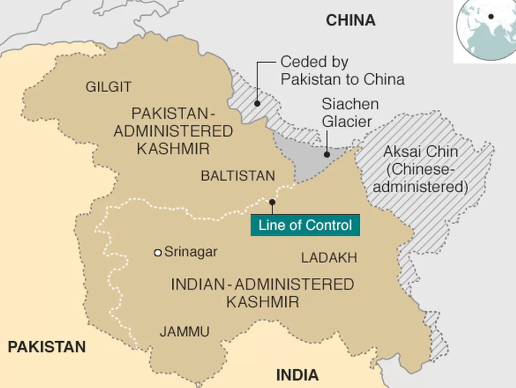
India has long maintained that Pakistan is responsible for funding violent separatist groups in the India-administered Kashmir, a claim Pakistan has denied on so many occasions. Since the Partition of India in 1947, the relationship between India and Pakistan has been very tense primarily over the disputed territory of Kashmir. Image: Disputed territory of Kashmir; Image credit: BBC
States are partitioned into smaller units usually as a means of resolving ethnic disputes globally. However, whether or not separating groups is an effective and wise way of promoting peace among groups that do not get along continues to enjoy vibrant debates by policymakers and scholars.
The exaggerated differences between Hindus and Muslims started emerging due to the manner in which the British colonial government handled India. Britain took to the habit of categorizing the various princely states by their religious identities. This simplistic view of the subcontinent failed to take into consideration the various nuanced factors. As a result, distrust and acrimony began to build up among communities that previously lived side-by-side in relative peace.
To make matters worse, Britain rolled out a system of merging politics with religion, resulting in people voting for candidates on religious lines. In effect, the colonial authorities created political seats reserved for either Muslims or Hindus.
The unresolved Kashmir problem has also caused a lot of rift between the two nuclear-armed countries. Per the provision in the Indian Independence Act, inhabitants of the princely state of Kashmir had the power to determine which country to join. Hari Singh, the maharaja of Kashmir, initially wanted an independent state of Kashmir; however, a couple of months after the independence, the maharaja opted for Kashmir to be in India. Singh’s decision did not sit well with the Muslim extremists in Pakistan. Since then, both countries have claimed the region in full.
Today, the hotly contested region has been divided into the Pakistan-administered Kashmir and the Indian-administered Kashmir. The latter side periodically witnesses severe clashes between Indian security forces and Muslims inhabitants who oppose Indian rule.
Further complicating the issue is the fact that India shares border with China in eastern Kashmir (i.e. the Aksai Chin border area). The two countries briefly fought in 1962 over control of Aksai Chin, with China emerging as the victor.
All in all, the unrest in the Kashmir has caused the deaths of several thousands of people. The United Nations (UN), numerous U.S. presidents, and world leaders have offered or tried to de-escalate the Kashmir Crisis; however, they have all proved futile.
In a move that further exacerbated the crisis, India’s BJP-led parliament on August 5, 2019, passed a bill that divided India’s part of Kashmir into two territories – Jammu and Kashmir, and Ladakh. However, India’s nuclear-armed neighbors – both Pakistan and China – strongly criticized the move, with the latter stating that it seriously infringed upon its territorial sovereignty.
As of the writing of this article, Kashmir remains one of the most militarized zones in the world, along with the Korean Demilitarized Zone (KDZ), which runs across the Korean Peninsula.





